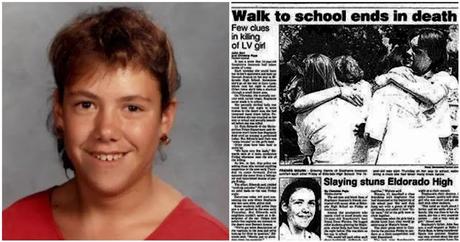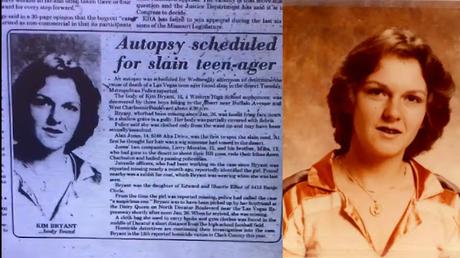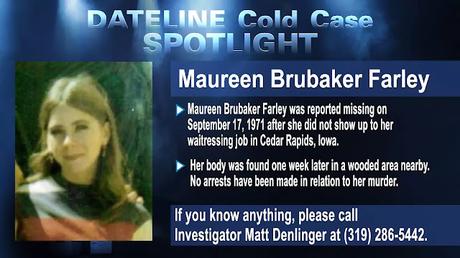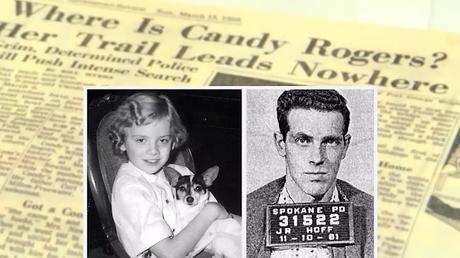Today, we're taking a look at five cases that despite being cold for decades and deemed unsolvable were finally solved in 2021. We will let you know now that we have saved the most shocking case for the very end.
Stephanie Isaacson Case

pic credit: Google Images
Today's first cold case goes back to 1989. 14-year-old Stephanie Isaacson was a freshman at Eldorado High School in Las Vegas when she left the apartment she shared with her dad around 6:30 am on the morning of June 1st, 1989 to head to school, but she never made it.
Stephanie was abducted on her way. Tragically, no one realized that Stephanie's absence from school was actually something far more sinister. Her choir teacher was the first to notice that Stephanie was missing since she normally ate lunch with her friends in the choir room.
Despite knowing that it was weird for Stephanie to miss school, no one contacted her father to report her absence. And no one realized she'd actually been taken. When she didn't come home, her family filed a police report and instantly began looking for Stephanie.
They rode horses into a desert lot where Stephanie would sometimes cut through on her way to school. That's where her father found her schoolbooks abandoned just a half-mile from her home. Police soon arrived with a helicopter and a ground search team. Soon after, Stephanie's keys were found in the lot.
Around 11:00 pm that night, a Las Vegas Police K-9 Unit found Stephanie's body about 25 yards from her books in the brush near a residential area. She'd been covered in an orange carpet. Stephanie had been assaulted, strangled, and beaten to death.
Her black hair was disheveled. Her jeans were pulled down. Her t-shirt pulled up. And there was evidence that part of her chest had been mutilated. One especially odd detail that the police noted was that her shoes were missing.
They were never found. After learning that his beloved daughter was dead, Stephanie's father called the local radio station. He asked them to play Stephanie's favorite song, Bette Midler's "Wind Beneath My Wings." At the beginning of the investigation, there were a few leads.
Neighbors living near the lot had seen a car parked in the area earlier on the day Stephanie died, but there were conflicting reports on its description. And so, the tip didn't lead to a suspect. Over the years, investigators traveled to Washington State, Ohio, and Texas to look into suspects, but never found anyone to connect to the case.
It continued this way for decades until her case was officially pronounced cold. (drawer closing) But there was still some hope as DNA evidence had been recovered from Stephanie's shirt. In 2021, a Las Vegas resident and philanthropist Justin Woo approached the Las Vegas Metropolitan Police Department.
Woo offered to donate money in order to pay for advanced DNA technology to be used in a cold case investigation, Woo donated $5,000 to pay for Othram Labs Incorporated, a Texas-based forensic sequencing lab whose sole mission is to solve cold cases.
After close examination, Othram was able to recover twelve-tenths of a nanogram of DNA from the sample, which is about 15 human cells. In comparison, the genetic test used for most genealogical websites requires at least 750 nanograms of DNA.
Still, Othram managed to use the small amount of evidence to create the genetic profile of Stephanie's killer. It took six months for scientists to process the evidence, but they were able to develop a genetic family tree for the suspect.
They narrowed the DNA evidence to a man named Darren Roy Marchand. The match actually set a world record for the least amount of DNA used in order to solve a case. In 1986, three years before Stephanie's death, Marchand had been charged with strangling 25-year-old Nanette Vanderburg.
Nanette had been found naked in the bathtub of her apartment. And Marchand's fingerprints were discovered nearby the body. Despite this piece of evidence, Marchand went free as investigators couldn't prove that he'd been the one to kill her.
In January 1989, Marchand was charged with five counts of open and gross lewdness after publicly exposing himself to five different women. He ended up pleading guilty to one of the counts, and the other four were dismissed.
For this, he served nine months of probation. At the time that Stephanie was killed, Marchand was married with a two-year-old daughter and had a son on the way.
Investigators now believe that Marchand had either seen Stephanie crossing through the desert lot on her way to school and decided at that moment to attack her, or he was lying and waiting there and she just happened to, unfortunately, cross his path.
After Marchand was connected to Stephanie's case in 2021, investigators compared the DNA found of Nanette and discovered it matched Marchand. Stephanie's killer managed to evade justice as Marchand, at 29 years old, took his own life six years after her death.
Kim Bryant Case

pic credit: Inside Edition
Now, onto our second cold case. Despite being different from our previous case in many ways, they share two very important similarities. They both happened in Las Vegas, Nevada, and they were both solved thanks to the same philanthropist.
16-year-old Kim Bryant was reported missing on January 26th, 1979 when she didn't come home after school. The last place she was spotted was at a Dairy Queen. Kim had apparently called her boyfriend at 10:00 am to get a ride home from the restaurant, which was across the street from her school.
He drove to the Dairy Queen to pick her up. But when he arrived around 10:45 am, Kim was no longer there. When she was eventually reported missing, her boyfriend went to the police to tell them what he knew.
A search began for the teenage girl but nothing turned up until five days later when her backpack was found abandoned with her purse, gym, clothes, and books. But still, there were no clues to what had happened to Kim.
Tragically, her body wasn't discovered for almost a month after she'd gone missing though her family and police had continued looking for her that entire time. Three children found her body as they played in a desert area. On closer inspection, police determined that there was evidence that she'd been assaulted before she died.
DNA evidence from a suspect, including semen, was found on her body. But unlike today, the technology to use this evidence simply didn't exist in 1979. And like many cases at the time, police struggled for years to identify a suspect in Kim's death.
Those years turned into decades and Kim's case officially went cold. That is until it took a surprising turn. Justin Woo once again offered to pay for a lab to review the DNA evidence of a cold case. Woo's donation was used to pay for Othram Labs to look into Kim's 42-year-old homicide case.
At the end of November 2021, Othram had completed genome sequencing to analyze the DNA evidence left on Kim's body. They took the sample and compared it across the various genealogical websites.
It was then that the first break in this cold case came. There was a match to a relative of the suspect. The lab contacted this relative who agreed to give a second sample for testing. With this sample, they found a match to a man named Johnny Blake Peterson.
Hearing the suspect's name, police revealed that they were shocked that Peterson matched the DNA sample. As you might be surprised to learn, he'd never been on the radar as a suspect. The sample was also verified by testing done by the Las Vegas Police Department's Forensic Lab.
Now, Peterson had a criminal history. He had previously been arrested for assault in April 1980, but the case was eventually dismissed. Peterson would have been 19 at the time that Kim was killed. With this new information, investigators have now been able to piece together more of the story about what might've happened to Kim.
They now believe that Kim may have been kidnapped by Peterson from the Dairy Queen or nearby on the day that she died. He then assaulted and killed her. However, they still don't know if Kim and Peterson knew each other before he took her or if it was a random attack.
Peterson had gone to the same high school as Kim. So, there was a chance they knew each other. Though he was no longer attending the school at the time that she was killed. Even though Kim's case was finally solved, it, like many other cold cases, doesn't exactly have a satisfactory ending. Peterson will never face justice for Kim's death because he died in January 1993.
As Peterson has passed away, we may never know the motive behind Kim's death. Despite this, Kim's father Edward Elliott finally had some sort of closure after decades without answers. But I have to tell you that this case doesn't end here and it only gets more tragic.
As of the first week of December 2021, the DNA evidence recovered in Kim's case was used to connect Peterson to another cold case that had been for 38 years. 22-year-old Diana Hanson was reported missing by her family on December 31st, 1983.
On that same day, her body was discovered. There was evidence she had been assaulted and DNA was recovered from the crime scene. Over the years, different leads were explored in Diana's case but none ever connected to a suspect.
But just after Kim's case was solved, investigators decided on a hunch to compare Peterson's DNA with the sample from Diana's crime scene. A week after solving one cold case, they found out that it was a match. Peterson had killed both young women four years apart.
As of this article, investigators are still looking to see if Peterson is connected to any other cold cases in the Las Vegas area. So, we guess we'll wait and see if they find anything.
Maureen Brubaker Farley Case

pic credit: Twitter
Now, it's time for today's third case that as you'll find out shows sometimes a mother's instincts are right, despite evidence to the contrary. 17-year-old Maureen Brubaker Farley went missing in 1971 from Cedar Rapids, Iowa.
She was last seen alive on September 17th of that year and was reported missing after she failed to show up for work as a waiter at a diner. Two teenage boys found Maureen's body a week later in a wooded ravine near a landfill, and what is today known as the Tait Cummins Park.
Her partially clothed body was left lying in the trunk of an abandoned junk car. Evidence indicated that Maureen had been killed somewhere else, and her body was put in the car sometime after she died. The fact that she wasn't wearing shoes but the bottoms of her feet were clean supported this theory.
Her death was caused by a skull fracture, likely from being hit on the head. There was also evidence that she had been assaulted before her death. Mary Brubaker, Maureen's mother, knew something and she couldn't keep it to herself any longer.
Six months after Maureen's death, she wrote to Cedar Rapids Police to tell them that she knew who was responsible for killing her daughter. She suspected that a man in his fifties named George Smith was her killer. Maureen knew Smith from the diner where she worked and he also worked at a nearby liquor store.
Unfortunately for us, Maureen's mother never publicly revealed why exactly she suspected Smith. Police interviewed Smith in 1971. And while there, he refuses to take a polygraph test. Though a bit suspicious, investigators never found any evidence to charge him with Maureen's death.
Even more suspicious was the fact that Smith would call to check in with the investigators and ask about any developments in the case, almost as if he was keeping tabs on it. Police struggled for years to find any evidence that would lead to a suspect.
It wasn't until 2006 when a detective reviewing Maureen's case discovered there was evidence from her assault that could be tested for DNA. They created a complete DNA profile for a male suspect. But unfortunately, it didn't come up with a match when it was submitted to the FBI's Combined DNA Index System.
This probably meant that whoever killed Maureen had never been charged with any other crime. Though this development was exciting and brought renewed hope to Maureen's family, her case still didn't go anywhere.
That is until the 50 year anniversary of Maureen's death, and what an anniversary it would be, police finally obtained a search warrant to collect DNA from a known relative of one of the suspects they'd considered in her case.
In October 2021, they finally had answers. Thanks to DNA technology that didn't exist when Maureen was killed in 1971, police were able to confirm on the anniversary of the day her body was discovered, September 24th, 2021, that George Smith had killed her. Maureen's mother, now 86, had been right all along. Smith was never prosecuted because he died in 2013 of old age at 94 years old.
Candice Candy Elaine Rogers Case

pic credit: Boston 25 News
All of the cold cases we've covered so far have been tragic, but our next one is not only the oldest case but heartbreaking because of the victim's age. On March 6th, 1959 in West Central, Spokane, the nine-year-old and fourth-grader Candice Candy Elaine Rogers left Holmes Elementary School and headed home.
On her way, she picked up seven boxes of Camp Fire Girls Mints as she was a member of the Blue Birds, an organization similar to the girl scouts. After going home for a while, she headed out again around 4:00 pm to sell the Mints by going door to door to her neighbors.
Candy was last seen alive while walking through her neighborhood in the afternoon and end of the night. Because it wasn't at all unusual to see children walking outside alone in the 50s, no one could be sure when they realize Candy was no longer there.
You see at this time, any people couldn't fathom that something horrible could happen to a child in a safe neighborhood. Everyone assumed Candy had simply gone back home, but she hadn't. Her mother, as most mothers do, had asked Candy to be home before it got dark, around 5:45.
When she didn't make it back, her entire family, mother, grandfather, friends, and neighbors, headed out to find her, but they couldn't find her. They called the police who joined the search around 8:00 pm. By 9:00 pm, six of Candy's seven Mint boxes were found abandoned on the street. She'd probably sold the seventh box. It was believed that she'd been kidnapped.
Some people even theorize that Candy had fought her attacker and thrown her Mint boxes out the window of the kidnapper's car in an attempt to get someone's attention. But the police couldn't confirm anything. A vast search, including 1,200 volunteers on foot, horseback, and cars and in the skies began in the hopes of finding Candy alive. However, another tragedy occurred during the search for Candy.
A helicopter flew by five Fairchild Air Force Base airmen accidentally flew into high voltage lines the day after Candy went missing. The chopper crashed into the Spokane River and three men died, but the two others managed to survive.
Just over two weeks after Candy had disappeared, two men were out hunting when they came across a pair of shoes near a tree. The shoes were Candy's. The next day, 16 days after she'd gone missing, Candy's body was found under a pile of pine needles where the hunters had seen her shoes. Only her knee cap had been visible where it stuck out from the brush.
Her feet were bound by a torn piece of her own clothes. She'd been assaulted, brutally attacked, and strangled with another piece of her clothing. Candy's shocking kidnapping and horrific death had an enormous impact on more than just her friends and family who were devastated by the loss.
The community of Spokane was rocked as a whole and parents began changing how late they let their children be outside because of fear of what happened to Candy. They also became warier of strangers.
During the early 1960s, there were a few leads in her case, including suspicions that the serial killer Hugh Bion Morse, who killed four women, two of who were from Spokane, was possibly involved in Candy's death. But the reason for the suspicion was odd. Mores was known to like grape-flavored gum.
And one of the detectives made a note that a stain on Candy's clothes looked like it was from gum and seemed to smell like grape. No other connection was ever found. Mores denied killing Candy. And eventually, Mores' DNA was tested against the stain and didn't match.
After this, Candy's case went cold. Sometimes, it takes a long time for pieces of evidence to come together, and that's exactly what happened with this case. Over 40 years after she'd been killed, investigators were finally able to collect enough bodily fluids from Candy's clothing in order to get a DNA sample.
Though they used it to eliminate one of their suspects as the sample wasn't a match. It didn't also match anyone in a federal database. Following six decades as an unsolved cold case, investigators referred to Candy's death as the Mount Everest of cold cases.
They feared that it would never be solved. Waiting until technology had advanced enough, investigators reached out in 2020 to a lab to try again and put a name to the DNA sample. But the lab said the sample was too old and degraded. So, they couldn't work with it.
Still, investigators didn't give up. In 2021, police used the services of a lab that specialized in analyzing degraded DNA evidence. The same Othram Labs used in Kim and Stephanie's cases to create a profile for a suspect. The lab did what no one else had been able to do.
They narrowed down the suspect to three brothers. The daughter of one of the brothers heard that her father was a suspect in Candy's case and offered to give a DNA sample to help narrow down the search. It was determined that her DNA was 2.9 million times more likely to be a genealogical match to the sample than a random person.
The suspect's body was exhumed in order to confirm the DNA. John Reigh Hoff, who'd been 19 at the time of Candy's death, was named as her killer. The result was a surprise to everyone. His name had never made it onto a list of suspects, and hadn't even been mentioned by anyone police had investigated over the years.
Without the DNA, he would never have been connected to Candy's death. Hoff took his own life in 1970 when he shot himself in the head at 31 years old. He had a history of issues with the law. When he was 16 in 1955, he ran away from state boys training camp.
After he was captured, he joined the military. Around the time that he died, his military records revealed that Hoff was living only one mile south of Candy's house. Two years after Candy was killed, Hoff was arrested for assaulting a woman and was in jail for six months.
Sadly, because it took 62 years to solve Candy's case and find her killer, both of her parents had died and will never know who killed their young daughter.
Lori Nesson Case

pic credit: 10 TV
You've made it to our final case. As we've seen so far, sometimes when one case is solved, so is another. On September 28th, 1974 in Reynoldsburg, Ohio, 15-year-old Lori Nesson went to a high school football game.
After the game, she hung out at a house party before walking home alone around midnight. This was the last time anyone saw her alive. Lori's naked body was found where it had been left, lying on the side of a road, while her clothing was discovered scattered across a few miles.
Despite the odd circumstances surrounding her death. Lori's cause of death was ruled as undetermined by a coroner. Her case, like so many others limited by the technology of the time, went cold with no leads and no answers.
It wasn't until 2020, 46 years after she was killed, that a police officer reopened the case and notice that there were inconsistencies in the police report. An autopsy photo showed that Lori had cuts on her lips, which looked like foul play.
The list of times of death also didn't seem to match the timeline of when she was last seen alive. The investigator brought all of these issues up with a superior. And finally, Lori's death was ruled to be a homicide.
In December 2020, a newscast aired the update on Lori's case. That same night, someone called the police with information. The person calling was the cousin of a woman named Karen Renee Adams. 17-year-old Karen had disappeared from Whitehall, Ohio on March 9th, 1975 as she was walking from her house to friends.
When she never showed up and her parents began to worry, they called the police to report that she was missing. Karen's body was found in a ditch the day after. This was just six months after Lori had been killed. As we are sure you noticed, the similarities between the cases were obvious.
In 2011, DNA evidence was used to connect two names to the Karen Adams case, Robert Meyer and Charles Webber. At that point, Webber had already died in 1992 at 53 years old. Because he'd been cremated, Webber's son offered to give a cheek swab to check the familial DNA.
The sample was used to confirm Webber's connection to Karen's murder. Meyer, on the other hand, was 70 years old when he was arrested in Cincinnati. He was sentenced to 15 years to life in prison. But he never served a full sentence as he died a few years after being imprisoned.
Investigators decided to test Robert Meyer and Charles Webber's DNA against the evidence they'd recovered from Lori's body. In 2021, they were both connected to Lori's killing. Meyer and Webber had a history of criminal activity, which resulted in them both spending time in the old Ohio Penitentiary during the 1960s, which is where they met.
Meyer was sent there to serve a 10-year sentence starting in 1963 after he killed a man with a hammer. Webber had been in prison for a robbery. The two men must have bonded while in the penitentiary because after they were released, they moved in together in 1974 and lived in Whitehall, Ohio.
While there, the two men were known to drink and drive around the city where they often approached women who were on their own. Investigators speculate that this is what may have happened to both Lori and Karen.
In 1977, Webber and Meyer were convicted of assaulting and kidnapping two women from the Toledo area. Today, the police are currently checking cold cases from 1974 to 1977 in the Columbus and Toledo area to see if the two men might be responsible for any more women's deaths.
For the families of Lori and Karen, they can't help but wonder if Lori's death had been considered a homicide from the beginning rather than undetermined if Karen's killing could have been prevented. But tragically, there's no way for us to ever know.

